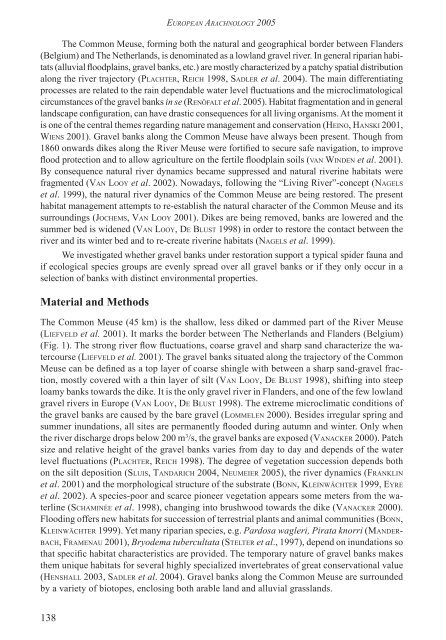(Araneae) of gravel banks and environmental constraints along a ...
(Araneae) of gravel banks and environmental constraints along a ...
(Araneae) of gravel banks and environmental constraints along a ...
You also want an ePaper? Increase the reach of your titles
YUMPU automatically turns print PDFs into web optimized ePapers that Google loves.
138<br />
EuropEan arachnology 2005<br />
The Common Meuse, forming both the natural <strong>and</strong> geographical border between Fl<strong>and</strong>ers<br />
(Belgium) <strong>and</strong> The Netherl<strong>and</strong>s, is denominated as a lowl<strong>and</strong> <strong>gravel</strong> river. In general riparian habitats<br />
(alluvial floodplains, <strong>gravel</strong> <strong>banks</strong>, etc.) are mostly characterized by a patchy spatial distribution<br />
<strong>along</strong> the river trajectory (plachtEr, rEich 1998, sadlEr et al. 2004). The main differentiating<br />
processes are related to the rain dependable water level fluctuations <strong>and</strong> the microclimatological<br />
circumstances <strong>of</strong> the <strong>gravel</strong> <strong>banks</strong> in se (rEnöFalt et al. 2005). Habitat fragmentation <strong>and</strong> in general<br />
l<strong>and</strong>scape configuration, can have drastic consequences for all living organisms. At the moment it<br />
is one <strong>of</strong> the central themes regarding nature management <strong>and</strong> conservation (hEino, hanski 2001,<br />
wiEns 2001). Gravel <strong>banks</strong> <strong>along</strong> the Common Meuse have always been present. Though from<br />
1860 onwards dikes <strong>along</strong> the River Meuse were fortified to secure safe navigation, to improve<br />
flood protection <strong>and</strong> to allow agriculture on the fertile floodplain soils (van windEn et al. 2001).<br />
By consequence natural river dynamics became suppressed <strong>and</strong> natural riverine habitats were<br />
fragmented (van looy et al. 2002). Nowadays, following the “Living River”-concept (nagEls<br />
et al. 1999), the natural river dynamics <strong>of</strong> the Common Meuse are being restored. The present<br />
habitat management attempts to re-establish the natural character <strong>of</strong> the Common Meuse <strong>and</strong> its<br />
surroundings (JochEms, van looy 2001). Dikes are being removed, <strong>banks</strong> are lowered <strong>and</strong> the<br />
summer bed is widened (van looy, dE Blust 1998) in order to restore the contact between the<br />
river <strong>and</strong> its winter bed <strong>and</strong> to re-create riverine habitats (nagEls et al. 1999).<br />
We investigated whether <strong>gravel</strong> <strong>banks</strong> under restoration support a typical spider fauna <strong>and</strong><br />
if ecological species groups are evenly spread over all <strong>gravel</strong> <strong>banks</strong> or if they only occur in a<br />
selection <strong>of</strong> <strong>banks</strong> with distinct <strong>environmental</strong> properties.<br />
Material <strong>and</strong> Methods<br />
The Common Meuse (45 km) is the shallow, less diked or dammed part <strong>of</strong> the River Meuse<br />
(liEFvEld et al. 2001). It marks the border between The Netherl<strong>and</strong>s <strong>and</strong> Fl<strong>and</strong>ers (Belgium)<br />
(Fig. 1). The strong river flow fluctuations, coarse <strong>gravel</strong> <strong>and</strong> sharp s<strong>and</strong> characterize the watercourse<br />
(liEFvEld et al. 2001). The <strong>gravel</strong> <strong>banks</strong> situated <strong>along</strong> the trajectory <strong>of</strong> the Common<br />
Meuse can be defined as a top layer <strong>of</strong> coarse shingle with between a sharp s<strong>and</strong>-<strong>gravel</strong> fraction,<br />
mostly covered with a thin layer <strong>of</strong> silt (van looy, dE Blust 1998), shifting into steep<br />
loamy <strong>banks</strong> towards the dike. It is the only <strong>gravel</strong> river in Fl<strong>and</strong>ers, <strong>and</strong> one <strong>of</strong> the few lowl<strong>and</strong><br />
<strong>gravel</strong> rivers in Europe (van looy, dE Blust 1998). The extreme microclimatic conditions <strong>of</strong><br />
the <strong>gravel</strong> <strong>banks</strong> are caused by the bare <strong>gravel</strong> (lommElEn 2000). Besides irregular spring <strong>and</strong><br />
summer inundations, all sites are permanently flooded during autumn <strong>and</strong> winter. Only when<br />
the river discharge drops below 200 m 3 /s, the <strong>gravel</strong> <strong>banks</strong> are exposed (vanackEr 2000). Patch<br />
size <strong>and</strong> relative height <strong>of</strong> the <strong>gravel</strong> <strong>banks</strong> varies from day to day <strong>and</strong> depends <strong>of</strong> the water<br />
level fluctuations (plachtEr, rEich 1998). The degree <strong>of</strong> vegetation succession depends both<br />
on the silt deposition (sluis, t<strong>and</strong>arich 2004, nEumEiEr 2005), the river dynamics (Franklin<br />
et al. 2001) <strong>and</strong> the morphological structure <strong>of</strong> the substrate (Bonn, klEinwächtEr 1999, EyrE<br />
et al. 2002). A species-poor <strong>and</strong> scarce pioneer vegetation appears some meters from the waterline<br />
(schaminéE et al. 1998), changing into brushwood towards the dike (vanackEr 2000).<br />
Flooding <strong>of</strong>fers new habitats for succession <strong>of</strong> terrestrial plants <strong>and</strong> animal communities (Bonn,<br />
klEinwächtEr 1999). Yet many riparian species, e.g. Pardosa wagleri, Pirata knorri (m<strong>and</strong>Er-<br />
Bach, FramEnau 2001), Bryodema tubercultata (stEltEr et al., 1997), depend on inundations so<br />
that specific habitat characteristics are provided. The temporary nature <strong>of</strong> <strong>gravel</strong> <strong>banks</strong> makes<br />
them unique habitats for several highly specialized invertebrates <strong>of</strong> great conservational value<br />
(hEnshall 2003, sadlEr et al. 2004). Gravel <strong>banks</strong> <strong>along</strong> the Common Meuse are surrounded<br />
by a variety <strong>of</strong> biotopes, enclosing both arable l<strong>and</strong> <strong>and</strong> alluvial grassl<strong>and</strong>s.
















